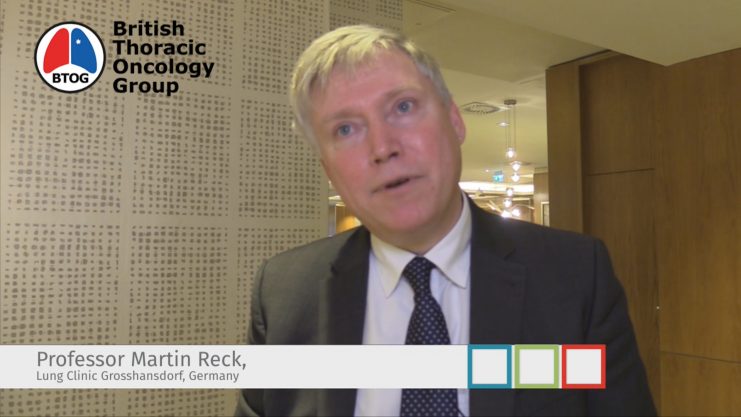Advertisment
Translational oncology: Tumour mutational burden and exploitation of DNA repair

Professor Ahmed gives an overview of one of the sessions in the BTOG Translational Oncology Symposium.
Interviews by Hannah Chatfield. Article by Christine Clark.
As the number of non-synonymous mutations in tumour tissue increases so the number of neo-antigens increases and some of the neo-epitopes may be foreign enough to trigger a T-cell response. If this happens it could be ‘enabled’ by checkpoint blockade, said Professor Gary Middleton (Professor of Medical Oncology, University of Birmingham, UK). Thus, the more non-synonymous mutations there are in a tumour, the more likely it is to respond to checkpoint inhibitors (CPIs). This is confirmed by research showing that progression-free survival (PFS) is better with CPIs in patients with high non-synonymous mutation burden. Moreover, this has been shown to hold across all tumour types. “55% of the differences in tumour objective response rates can be attributed to TMB” said Professor Middleton. The results from the Checkmate 026 study showed that patients who had both a high TMB and a high level of PD-L1 expression achieved a 75% objective response rate with nivolumab treatment. The mutations need to be clonal alterations for a good kill rate, he added.
This picture does not occur with chemotherapy. However, chemotherapy affects the permeability of tumour cells to granzyme B (GrzB). (GrzB is secreted by cytotoxic T lymphocytes (CTLs) and induces target cell apoptosis.) Because chemotherapeutic agents up-regulate GrzB receptor expression, they have a ‘bystander effect’ that enhances the activity of immunotherapy. “Combined chemotherapy and IO works through this mechanism”, said Professor Middleton.
A biopsy or a blood surrogate is needed to measure TMB. In practice, a cut-off value of more than 16 mutations per megabase in blood has been shown to be the best value for separating high and low TMB values.
TMB is clearly a predictive biomarker for the activity of IO – patients with high TMB derive more benefit than those with low TMB. It would be useful to identify patients who are unlikely to derive any benefit from IO and avoid the burden of side effects. The important question that remains to be answered is, “Does TMB tell us who will get no benefit from any IO in first-line treatment and who should receive IO/IO rather than IO/chemo?” said Professor Middleton.
DNA repair
It may be possible to exploit the addiction to DNA repair pathways in cancer cells to treat cancer, according to Dr Kenneth O’Byrne (Queensland University of Technology, Brisbane, Australia).
The human body is subject to about 40,000 DNA-damaging events per day due to oxidative stress, smoking, sun exposure and chemotherapy, amongst others. Most are satisfactorily repaired but when double-stranded breaks do not repair properly the result is genomic instability and the risk of cancer. Many cancers have dysregulated DNA repair pathways and this could provide a window of opportunity for treatment. In essence, because the cancer cells have some defective or inefficient DNA repair mechanisms they become addicted to other pathways. If these ‘rescue’ mechanisms can be inhibited (by a suitable drug) then cancer cells are prevented from replication, leading to apoptosis. This phenomenon is known as ‘synthetic lethality’.
One important DNA-repair protein – originally discovered in archaea that survive in extremely inhospitable environments such as volcanic hot springs – is single-stranded DNA-binding protein (SSB). SSBs are critical for DNA replication, recombination and repair. The human equivalent is hSSB1 – sometimes described as a ‘critical guardian of the genome’. This protein is overexpressed in cancer cells and is associated with a poor prognosis. Knockdown or depletion of hSSB1 leads to selective killing of cancers cells, including lung cancer cells.
DNA repair proteins are intracellular, in the cytoplasm and nucleus, and so they are difficult to reach, for example, antibodies do not readily cross cell membranes. DNA-dependent protein kinase (DNA-PK) activates hSSB1 and DNA-PK inhibitors (DNA-PKis) are small molecules that have been shown to reduce non-small cell lung cancer (NSCLC) cell proliferation in vitro. Effectively, DNA-PKis switch off the cancer cells’ DNA repair machinery making their genetic code unstable and leading to cell death. These agents have reduced tumour growth in the mouse prostate cancer model. One such agent, DKLS02, was effective against chemo-resistant NSCLC with efficacy equivalent to cisplatin in vitro. However, unlike cisplatin it did not cause weight loss. Clinical trials are expected in 2019, said Professor O’Byrne.
A number of other proteins are involved in the DNA repair process and many are the subjects of active research. “We are now on threshold of breakthrough by virtue of our ability to target proteins inside cells”, concluded Professor O’Byrne.
Based on presentations given at the 17th Annual BTOG Conference, Dublin, January 2019





